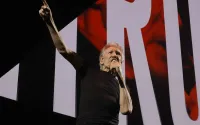20 November 2006John Heilemann
Last spring, green-design guru William McDonough got a mysterious call from Steven Spielberg. Though Spielberg didn't explain why, he invited McDonough to visit him in Los Angeles. McDonough went - and learned that the Hollywood icon wanted to produce a documentary about McDonough's work.
"He'd just seen Al Gore's movie and felt it would be great to make a film about what people are doing about [global warming]," McDonough tells me. "The ending of Gore's film is tragic, because after showing the scale of the catastrophe, he says, 'There's some hope here,' but the hope is what? Buy hybrid? Change your lightbulbs? It's not enough!"
Certainly it's not enough for McDonough - the former dean of the University of Virginia School of Architecture and head of two pathbreaking design firms in Charlottesville, Va. - whose eco-friendly schemes are sweeping, radical, and "head-twisting," as McDonough puts it. Recyclable cars. Server farms powered by wind. Entire cities with factory roofs covered with vegetation.
Yet, far-out as all this sounds, McDonough's ideas are gaining currency in unexpected places, from corporate boardrooms to the Chinese government. And while some of his dreams are unlikely to become reality, they point the way to a future where business and the environment are friends, not foes; where innovation and conservation are entwined; where maximizing profit and saving the planet are synonymous.
McDonough, 55, studied art and architecture at Dartmouth and Yale, where he was heavily influenced by Stewart Brand's Whole Earth Catalog. He made a name for himself in 1985 with his design of the New York headquarters of the Environmental Defense Fund - one of the country's first green offices.
His signature projects since then have included offices for Gap Inc. (its grass-covered roof absorbs storm water and damps the sound of jets flying overhead) and Herman Miller (the building's solar cooling and lighting design cut the company's energy costs by 25 percent), as well as the ongoing $2 billion redesign of Ford's River Rouge complex (which features a 10-acre green roof and a system that converts paint exhaust fumes into electrical power).
When I visit McDonough in Charlottesville, he delights in showing me miniature models and vivid renderings of his current projects. To my untrained eye, they seem fanciful to the point of fantasy.
"We get paid to dream," McDonough says. "Our job is to imagine the exquisitely perfect in order to achieve the practically impossible."
For McDonough, that motto applies equally to his work beyond architecture. In Cradle to Cradle, the book he coauthored in 2002, McDonough called for perfectly regenerative products: "Every element should either go back to the soil safely" - be nontoxic and biodegradable - "or go back to industry and be infinitely recyclable," he says.
To encourage companies to this end, he has set up a certification process to bestow on products that meet his standards a cradle-to-cradle label.
What sets McDonough apart from standard-issue greens is his belief that business, driven not by altruism but by pragmatism, is increasingly in the vanguard of eco-progress.
Here he points to Silicon Valley. "It's becoming clear the dematerialization of information is not a benign environmental event," he says. "The Internet is going to be one of the largest power consumers in the world... The awareness in companies is intense. It's driving costs; it's a contingent liability just waiting to strike."
McDonough has his own ideas about how to address this problem. ("I'd put the server farms in the Great Plains," he says. "You could run them using windmills, and hey, guess what, it's cold in Minnesota - and what do server farms need? Cooling.")
But, not surprisingly, he expects that Google (Charts) will emerge as a powerful environmental innovator. Why? Because the company recently hired one of McDonough's firms to work on its campus.
McDonough's faith in business doesn't stop with entrepreneurial outfits. He thinks corporate titans - Ford (Charts), Procter & Gamble (Charts), Wal-Mart (Charts) - can be even greater forces for good. "If a company wants to do business in Sweden and India, they're going to have to adopt the Swedish standards," he explains.
"We've seen this already with Coke and Pepsi, which are effectively out of business in parts of India because the Indians woke up one day and said, 'The water quality you guys use in Germany is at a higher standard than in India. Are Germans more important than Indians?'"
Few people look at globalization and see a race to the top in environmental standards. Even fewer study China (in this context) and detect, as McDonough does, "a harbinger of hope." His reasoning is that if China adopts solar power to meet its vast and growing appetite for energy, it might drive the price of solar below the price of burning coal, spawning mass-produced technology that could be deployed around the world.
"It's an amazing gift that China could give us," McDonough says.
Before you dismiss him as a Sino-Pollyanna, understand that McDonough knows a lot more about China than you do. He and his people have been helping to design seven new Chinese communities (six cities, one village) using rigorous standards of ecological sustainability.
In one, they're developing a water strategy for a town with open sewers; in another, a solar-powered central city. For still another, McDonough conceived a ground-up master plan in which displaced farmland is moved onto the city's rooftops.
"We got three responses," he says. "'You're totally nuts!' 'How do you do that?' 'Fabulous, let's try it!' Pretty much the same three things that we always hear."
The China projects have been sobering for McDonough. He harbors no illusions that his firm's hard - and often visionary - work will be implemented in a way that satisfies him.
"Some of it has been neither fun nor rewarding: seeing local entrepreneurs executing our plans in ways that surprise us without delighting us, doing truly frightening stuff," he says.
And yet, in the end, McDonough has no regrets. "I now know things about building a Chinese village that no one else does," he says. "It's an incredible learning laboratory."
McDonough's indefatigable optimism sometimes borders on naïveté. But together with his abject refusal to acknowledge arbitrary limits, it's what makes him so compelling. As McDonough himself relays, "Somebody joked yesterday, 'Some people see the glass as half-empty and others see it as half-full. Bill doesn't think it's big enough.'"
It isn't hard to imagine why Steven Spielberg wants to make a movie about McDonough. If you're anything like me, when the thing comes out, you'll be first in line to see it.
John Heilemann wrote "Pride Before the Fall." His next book is "The Valley." He lives in Brooklyn. ![]()






